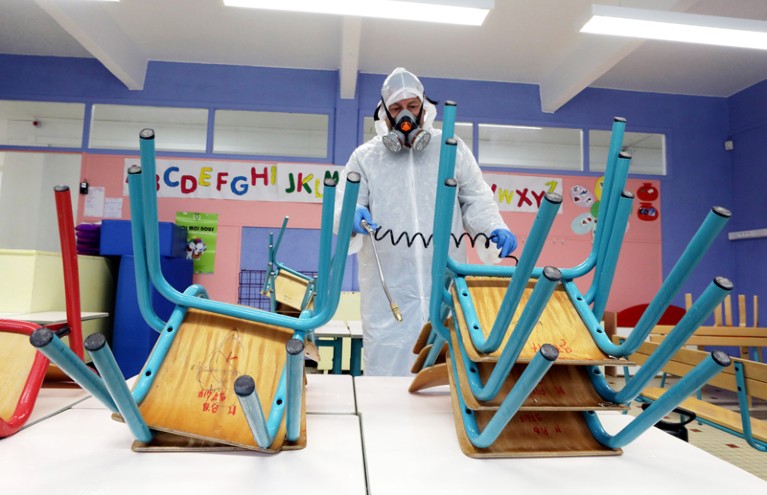
As some countries begin to ease lockdowns, the World Health Organization is urging that the virus must continue to be aggressively contained.Credit: Eric Gaillard/Reuters
When can lockdowns be lifted, and how should this happen? These urgent questions are being asked in each of the 180 or so countries and territories that enacted full or partial restrictions on movement in response to the new coronavirus. But as countries start tentatively to reopen schools, businesses and public places, it is also becoming clear that there is little consensus on how this should be done, because efforts to coordinate actions globally are running into the ground.
The need to get countries back to work is, of course, urgent. According to the International Labour Organization (ILO), an agency of the United Nations, stay-at-home orders have imperilled the lives and livelihoods of at least 1.6 billion people. The majority are workers who have no income or health protections and whose work cannot be done from home. No work means no food, and no money to pay rent. Governments have stepped in with various forms of temporary financial assistance, but they have also taken on large debts to provide this support.
Researchers are warning that when this financial support ends, the ill health induced by poverty could worsen. The World Food Programme is warning that 265 million people will experience acute hunger by the end of 2020 — twice the number facing food crises before COVID-19 (see go.nature.com/3c8aebj).
Whose coronavirus strategy worked best? Scientists hunt most effective policies
All of this is adding to pressure to reopen economies and societies. Yet the pandemic has not yet run its course, and infections and deaths continue to rise. If restrictions are lifted prematurely, the impacts of the virus risk being prolonged.
The World Health Organization published guidance last month for countries considering easing some restrictions — advice that is intended to minimize a risk of a resurgence of the virus (see go.nature.com/2a4jdmt). There can be no one-size-fits-all solution to easing restrictions. However, guided by systematic reviews of the peer-reviewed literature, and by its decades of experience in dealing with infectious diseases, the agency recommends that, in any scenario, disease transmission must be controlled — otherwise, without a vaccine, there’s a risk that the virus will return. In many countries, transmission is uncontrolled and must be reduced so that cases arise only sporadically, or in clusters in identifiable regions. This, in turn, requires public-health systems to detect, test, isolate and treat cases of infection, and to trace people who had been in contact with those infected — something that would require large teams of contact-tracers.
The WHO’s guidance, in addition, says that countries need to minimize transmission in potential hotspots, such as care homes or large gatherings; and that places where people gather — for example, schools and workplaces — should be provided with equipment to ensure that physical distancing can be implemented. The agency is also clear — as is the ILO — that governments must continue to provide financial and other forms of support to protect the most vulnerable groups.
By 1 May, according to researchers at the University of Oxford’s Blavatnik School of Government, UK, no country had met even four of the six WHO criteria that a 150-member team convened by the university has been measuring. And only 20 countries and territories, including Trinidad and Tobago, Croatia, Hong Kong and South Korea have come close (see go.nature.com/2zbs1ef).
Coronavirus and COVID-19: Keep up to date
This is largely because most countries (more than 150) have not yet met the first requirement — for COVID-19 to be reduced to sporadic cases and identifiable clusters. Moreover, at least 50 countries still lack adequate policies for testing, contact-tracing and isolating infected individuals. Such measures, along with physical distancing, have also been essential in helping to keep China’s cases under control since travel restrictions were lifted in February — as research published this week in Nature confirms (S. Lai et al. Nature https://doi.org/10.1038/s41586-020-2293-x; 2020).
On 4 May, the international community — led by European Union member states and global philanthropic funders — raised US$8 billion for research and development on COVID-19 and pledged to work with the WHO to accelerate efforts to develop vaccines and drugs. Such collaboration is essential and is to be welcomed, because it will ensure that communities in all countries can eventually be protected from the disease. But paying attention to the WHO’s guidelines, and sharing best practice on easing lockdowns, is essential, too.
Countries are having to make difficult decisions as lockdowns are eased. And they are doing so while their researchers are still gathering and processing data. These data should be published and shared. Circumstances in individual countries will necessarily be different, but the world will benefit from the mutual learning that will come from such a global effort.

 Coronavirus and COVID-19: Keep up to date
Coronavirus and COVID-19: Keep up to date
 Whose coronavirus strategy worked best? Scientists hunt most effective policies
Whose coronavirus strategy worked best? Scientists hunt most effective policies
 As lockdowns lift, new hazards lurk in the water
As lockdowns lift, new hazards lurk in the water
 Coronavirus: three things all governments and their science advisers must do now
Coronavirus: three things all governments and their science advisers must do now



